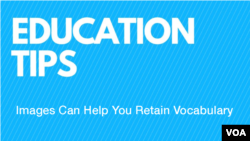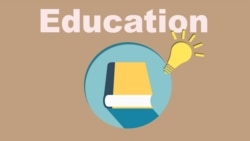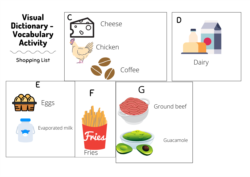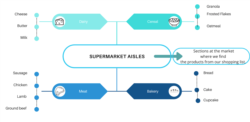Suppose you are listening to a program in English and hear the word “borrow.” You have heard this word many times but forget its meaning. So, you look up the equivalent word in your own language. Ahh, yes, now you remember! A few days later, you see the word again, but again cannot remember its meaning. Why?
It is easy to blame yourself or think, “I have a terrible memory!” But your memory is not the problem.
The problem is that translating a word to its equivalent word in your language is not an effective way to learn vocabulary. This is because it does not create strong connections in the brain, something critical for remembering information.
To really learn words, you have to bring attention to them and connect them with mental images or your existing knowledge. This helps your brain recall words quickly and easily when you need them. On today’s Education Tips, we will discuss three methods that use images to retain vocabulary.
1-Use pictures
First, let’s discuss the most straightforward method: Using pictures as visual aids.
Danielle Zelin is an English teacher and teacher trainer. She has taught for nearly 25 years, including in South Africa, Latvia and Mauritius, her homeland.
Zelin says visual aids are important for language learners because humans think in images.
“When we hear a sentence...[when] somebody is talking to us, we see the pictures. We don’t see the words. We don’t see the sentence in our brain. Like ‘Yesterday, I went to the beach.’ If I tell you that, you will see me on the beach. You will not see the sentence in written form.”
She uses pictures or images with her beginning students and some of her mid-level students.
Cristiane Galvão has used pictures to teach vocabulary to students of every level, from grade school to the university level.
Galvão, who is based in California, has taught English for 20 years, including in the United States and Brazil.
She suggests learners make visual dictionaries with pictures from the internet, for example. This would involve writing an English word next to its image. Before you make the dictionary, think about your goals, she says. If the goal is to reinforce what you already learned about, put the words in alphabetical order. And organize them into related groups. But if the goal is to write a sentence using each new word, then you probably do not need to put the words into groups.
2-Use mnemonics tools
Next, let’s talk about mnemonics.
These are mental tools you can use to recall information better. Most mnemonics tools involve creating mental imagery to trigger your memory. Some of you have probably already done this without realizing there is a name for it.
One great mnemonics tool is keywords. This involves making a mental image that ties two similar-sounding words together.
Take the word “bald” as an example. It means having little or no hair. The word “ball” sounds like “bald” and can help us remember the target word. In your mind, make a mental picture of a ball with a face on it. Then, picture it with no hair on top, maybe a little on the sides. Keep this image in your mind for maybe 15 seconds. The next time you try to recall “bald,” it will be easier because of the keyword and connected imagery.
Alex Mullen is a biomedical engineer and one of the world’s top memory competitors. In 2016, he was the USA Memory Champion. Mullen calls the mnemonics keywords tool “the art of memory” because your mind makes a kind of picture stories.
In his video on mnemonics keywords, he talks about remembering the target word “corral” by joining its imagery with an image of a sea coral. He draws a group of stick figures trapped -- or corralled – in a coral. In real life, you would probably make a mental image rather than a drawing. But Mullen’s drawing demonstrates the idea of connecting a mental image of the target word with its keyword.
3-Use word maps
One final method for today is word maps, also known as semantic maps or word webs.
In a word map, you write a central word or idea in the middle and connect it with lines to related words. This helps to build mental associations between related ideas.
Danielle Zelin gives the example of the word “sharp.” If you center that word, you can connect it to words of things that are sharp, such as knife, paper and scissors.
Zelin says words are much easier to remember when they have meaning in your own life. For instance, one of her French students has an English-speaking dentist. So, she learned words that she needed for her recent dental visit.
Cristiane Galvão also says that context is important. She uses word maps in the classroom only after she has already discussed a subject and shown pictures. This makes the words meaningful before putting them into map form. Otherwise, she says, you are just reading and memorizing words, which is a bad idea.
“Vocabulary is a big part of language learning. So, the more meaningful it is, the easier it is for the student to absorb.”
Galvão says not every student will learn through a word map. But the maps can help you visualize and create a method that works for you.
I’m Alice Bryant.
Alice Bryant wrote this story for VOA Learning English. Susan Shand was the editor.
______________________________________________________
Words in This Story
translate - n. to change words from one language into another language
association - n. a feeling, memory, or thought that is connected to a person, place or thing
visual - adj. relating to seeing or to the eyes
alphabetical - adj. arranged in the order of the letters of the alphabet
trigger - v. to cause something to start or happen
corral - v. to gather together and confine a group of people or things
coral - n. a hard material formed on the bottom of the sea by the skeletons of small creatures
stick figure - n. a very simple drawing of a person or animal, composed of a few lines, curves and dots
context - n. the situation in which something happens
absorb - v. to learn something










